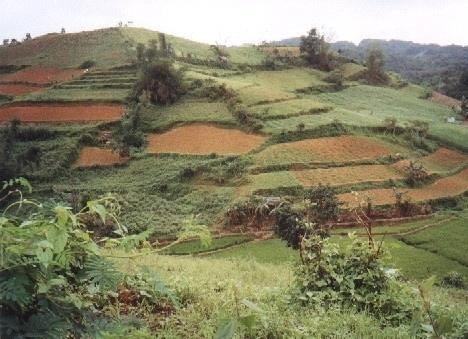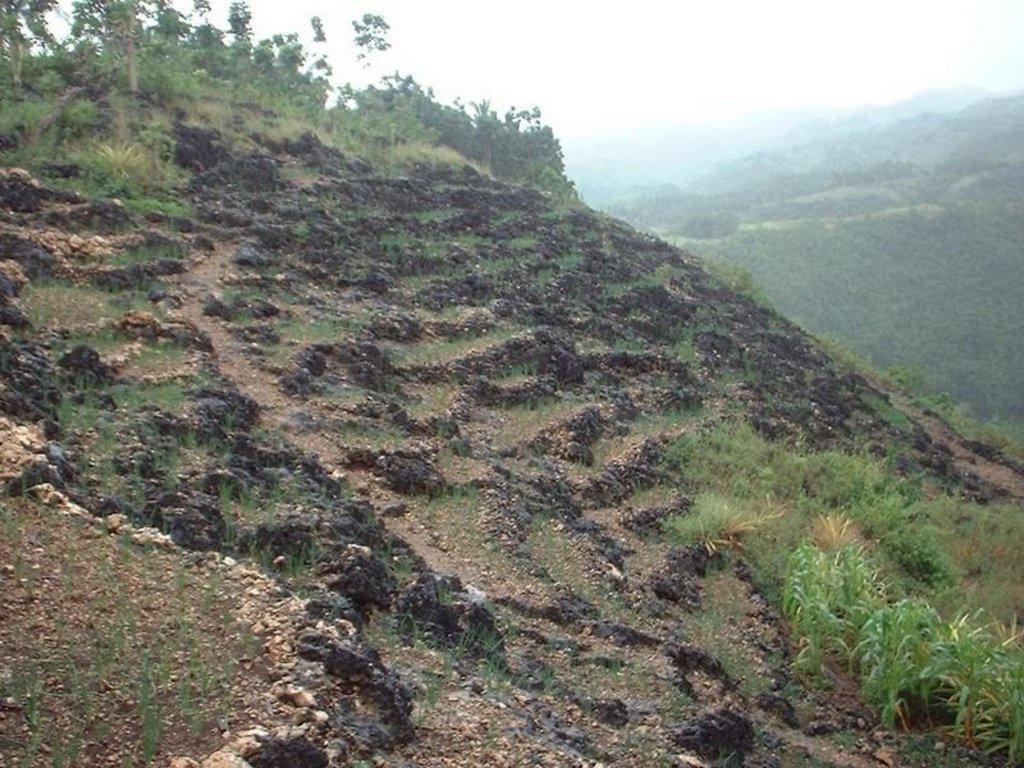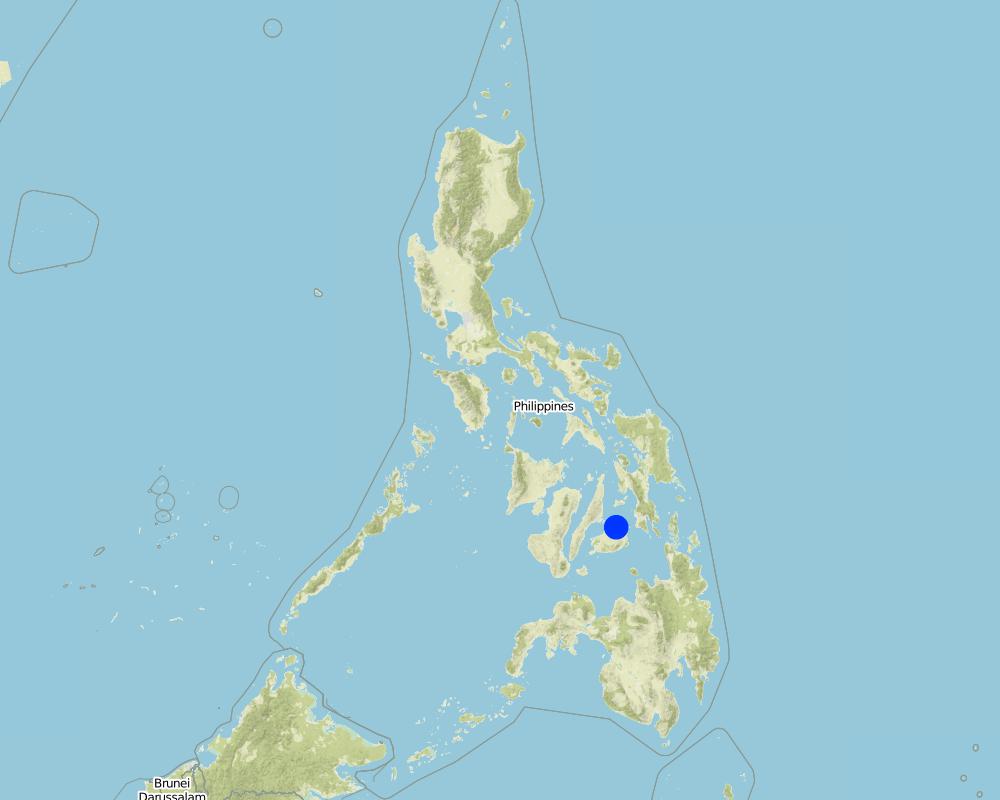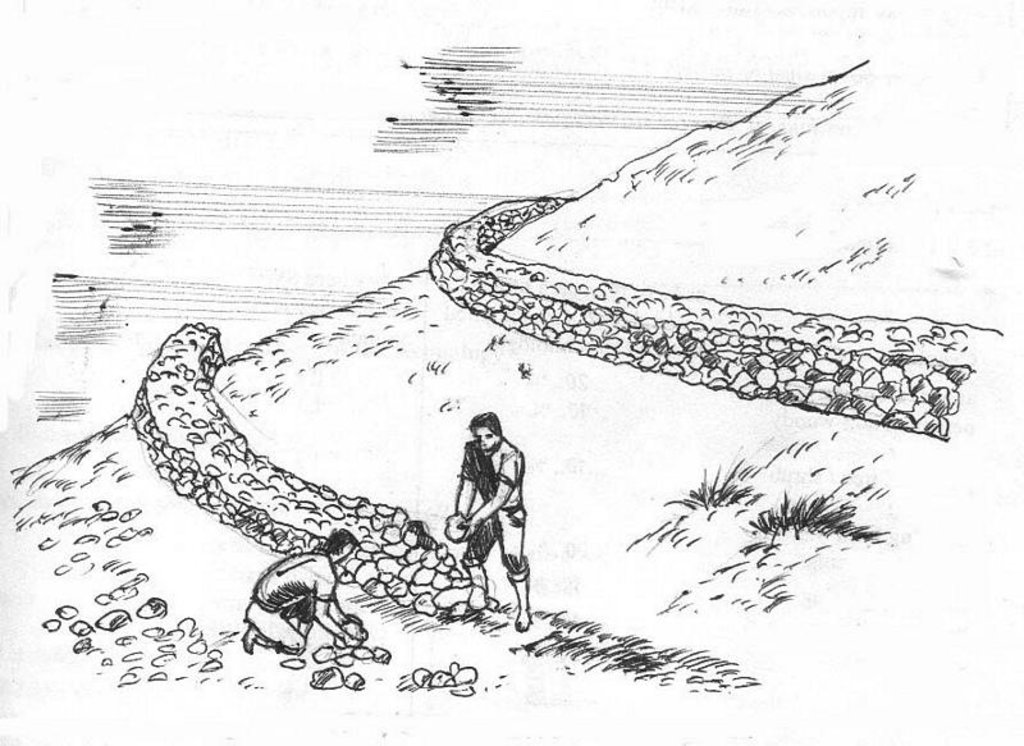Stone bunds and small basins [Philippines]
- Creation:
- Update:
- Compiler: Philippine Overview of Conservation Approaches and Technologies
- Editor: –
- Reviewers: Deborah Niggli, Alexandra Gavilano
Pamugong sa yuta (Cebuano)
technologies_1424 - Philippines
View sections
Expand all Collapse all1. General information
1.2 Contact details of resource persons and institutions involved in the assessment and documentation of the Technology
Key resource person(s)
SLM specialist:
Rondal Jose
Bureau of Soils and Water Management
Philippines
1.3 Conditions regarding the use of data documented through WOCAT
The compiler and key resource person(s) accept the conditions regarding the use of data documented through WOCAT:
Yes
1.4 Declaration on sustainability of the described Technology
Is the Technology described here problematic with regard to land degradation, so that it cannot be declared a sustainable land management technology?
No
2. Description of the SLM Technology
2.1 Short description of the Technology
Definition of the Technology:
Piling of stones and rocks along the contour to control run-off and soil erosion. It is also about the creation of small basins by removing stones and using them as barriers.
2.2 Detailed description of the Technology
Description:
This is a low-cost erosion control technology by piling stones/rocks along the contour. The spacing of the piles depends on the slope and the availability/abundance of surface rocks. The stone bunds, usually 0.4 meter wide is intended to slow down run-off and catch/impound soil that moves downslope, etiher by water or by gravity. The technology is also about the creation of small basins by removing rocks and using them as barrier. In these small basins, water is impounded and allow to infiltrate. Soil carried with the run-off is deposited in these basins for the raising of high value crops. The technology is most especially applicable in areas where limestone and other rock outcrops and where the soil is commonly shallow and skeletal. With time, natural terraces can form. Limestone/rock outcrops are also used in the construction of check dams along small waterways. These check dams will result in the formation of flat-bottom valleys where transplanted rice is usually grown. Series of check dams will form terraces along valley floor in the long run.
2.3 Photos of the Technology
2.5 Country/ region/ locations where the Technology has been applied and which are covered by this assessment
Country:
Philippines
Further specification of location:
Siquijor, Cebu, Bohol, Negros Oriental
Specify the spread of the Technology:
- evenly spread over an area
If the Technology is evenly spread over an area, specify area covered (in km2):
31.0
Comments:
Total area covered by the SLM Technology is 31 km2.
The technology of pilling stones along the contour has been praticed for generation. However, it was given an added push through the Central Visayas Resources Project (CVRP). It is a case of promoting farmers' initiative (PFI).
Map
×2.6 Date of implementation
If precise year is not known, indicate approximate date:
- more than 50 years ago (traditional)
2.7 Introduction of the Technology
Specify how the Technology was introduced:
- as part of a traditional system (> 50 years)
Comments (type of project, etc.):
Indigenous to the area.
3. Classification of the SLM Technology
3.1 Main purpose(s) of the Technology
- reduce, prevent, restore land degradation
3.2 Current land use type(s) where the Technology is applied

Cropland
- Annual cropping
Annual cropping - Specify crops:
- cereals - maize
- vegetables - root vegetables (carrots, onions, beet, other)
Number of growing seasons per year:
- 2
Specify:
Longest growing period in days: 270, Longest growing period from month to month: May - Jun; Second longest growing period in days: 240, Second longest growing period from month to month: May - Dec
Comments:
Major land use problems (compiler’s opinion): Soil erosion/degradation, soil fertility decline
Major land use problems (land users’ perception): productivity decline, increasing levels of input to maintain yield.
Type of cropping system and major crops comments: Two (2) crops of onion or two crops of corn or one crop of corn followed by vegetables.
3.4 Water supply
Water supply for the land on which the Technology is applied:
- rainfed
3.5 SLM group to which the Technology belongs
- cross-slope measure
3.6 SLM measures comprising the Technology

structural measures
- S2: Bunds, banks
3.7 Main types of land degradation addressed by the Technology

soil erosion by water
- Wt: loss of topsoil/ surface erosion
- Wg: gully erosion/ gullying

water degradation
- Ha: aridification
3.8 Prevention, reduction, or restoration of land degradation
Specify the goal of the Technology with regard to land degradation:
- restore/ rehabilitate severely degraded land
4. Technical specifications, implementation activities, inputs, and costs
4.1 Technical drawing of the Technology
Technical specifications (related to technical drawing):
Construction of stone bunds along the contour for run-off and erosion control
Date: 8-22-2002
Technical knowledge required for field staff / advisors: moderate
Technical knowledge required for land users: moderate
Main technical functions: control of concentrated runoff: retain / trap
Secondary technical functions: reduction of slope length, increase / maintain water stored in soil
Author:
Lorenzo Co
4.2 General information regarding the calculation of inputs and costs
other/ national currency (specify):
Philippine peso
If relevant, indicate exchange rate from USD to local currency (e.g. 1 USD = 79.9 Brazilian Real): 1 USD =:
50.0
Indicate average wage cost of hired labour per day:
4.00
4.4 Costs and inputs needed for establishment
| Specify input | Unit | Quantity | Costs per Unit | Total costs per input | % of costs borne by land users | |
|---|---|---|---|---|---|---|
| Labour | labour | ha | 1.0 | 1000.0 | 1000.0 | 100.0 |
| Equipment | tools | ha | 1.0 | 20.0 | 20.0 | 100.0 |
| Total costs for establishment of the Technology | 1020.0 | |||||
| Total costs for establishment of the Technology in USD | 20.4 | |||||
4.6 Costs and inputs needed for maintenance/ recurrent activities (per year)
| Specify input | Unit | Quantity | Costs per Unit | Total costs per input | % of costs borne by land users | |
|---|---|---|---|---|---|---|
| Labour | labour | ha | 1.0 | 40.0 | 40.0 | 100.0 |
| Total costs for maintenance of the Technology | 40.0 | |||||
| Total costs for maintenance of the Technology in USD | 0.8 | |||||
Comments:
The volume of stones to be removed, gathered and piled to create a wall.
4.7 Most important factors affecting the costs
Describe the most determinate factors affecting the costs:
Labor for the removal and collection of stones for piling.
5. Natural and human environment
5.1 Climate
Annual rainfall
- < 250 mm
- 251-500 mm
- 501-750 mm
- 751-1,000 mm
- 1,001-1,500 mm
- 1,501-2,000 mm
- 2,001-3,000 mm
- 3,001-4,000 mm
- > 4,000 mm
Agro-climatic zone
- humid
- sub-humid
Thermal climate class: tropics
5.2 Topography
Slopes on average:
- flat (0-2%)
- gentle (3-5%)
- moderate (6-10%)
- rolling (11-15%)
- hilly (16-30%)
- steep (31-60%)
- very steep (>60%)
Landforms:
- plateau/plains
- ridges
- mountain slopes
- hill slopes
- footslopes
- valley floors
Altitudinal zone:
- 0-100 m a.s.l.
- 101-500 m a.s.l.
- 501-1,000 m a.s.l.
- 1,001-1,500 m a.s.l.
- 1,501-2,000 m a.s.l.
- 2,001-2,500 m a.s.l.
- 2,501-3,000 m a.s.l.
- 3,001-4,000 m a.s.l.
- > 4,000 m a.s.l.
5.3 Soils
Soil depth on average:
- very shallow (0-20 cm)
- shallow (21-50 cm)
- moderately deep (51-80 cm)
- deep (81-120 cm)
- very deep (> 120 cm)
Soil texture (topsoil):
- medium (loamy, silty)
- fine/ heavy (clay)
Topsoil organic matter:
- medium (1-3%)
5.6 Characteristics of land users applying the Technology
Market orientation of production system:
- mixed (subsistence/ commercial)
- commercial/ market
Off-farm income:
- 10-50% of all income
Relative level of wealth:
- poor
- average
Level of mechanization:
- manual work
- animal traction
Indicate other relevant characteristics of the land users:
Population density: 100-200 persons/km2
Annual population growth: 2% - 3%
30% of the land users are rich and own 20% of the land.
10% of the land users are average wealthy and own 30% of the land.
60% of the land users are poor and own 50% of the land.
Off-farm income specification: retailing, carpentry, dressmaking, fishing, overseas employment, etc.
5.7 Average area of land used by land users applying the Technology
- < 0.5 ha
- 0.5-1 ha
- 1-2 ha
- 2-5 ha
- 5-15 ha
- 15-50 ha
- 50-100 ha
- 100-500 ha
- 500-1,000 ha
- 1,000-10,000 ha
- > 10,000 ha
5.8 Land ownership, land use rights, and water use rights
Land ownership:
- individual, titled
Land use rights:
- individual
6. Impacts and concluding statements
6.1 On-site impacts the Technology has shown
Socio-economic impacts
Production
crop production
Comments/ specify:
from nothing to something
production area
Comments/ specify:
area occupied by stone wall
land management
Comments/ specify:
stone wall is also on obstruction
Income and costs
farm income
Comments/ specify:
from nothing to something
Socio-cultural impacts
conflict mitigation
Ecological impacts
Water cycle/ runoff
surface runoff
Quantity before SLM:
40
Quantity after SLM:
10
Soil
soil moisture
Comments/ specify:
Better infiltration
soil cover
Comments/ specify:
Better crop growth
soil loss
Comments/ specify:
Almost zero soil loss
Other ecological impacts
Soil fertility
Comments/ specify:
Build-up of nutrients
6.2 Off-site impacts the Technology has shown
downstream flooding
groundwater/ river pollution
6.4 Cost-benefit analysis
How do the benefits compare with the establishment costs (from land users’ perspective)?
Short-term returns:
slightly positive
Long-term returns:
very positive
How do the benefits compare with the maintenance/ recurrent costs (from land users' perspective)?
Short-term returns:
positive
Long-term returns:
positive
6.5 Adoption of the Technology
Of all those who have adopted the Technology, how many did so spontaneously, i.e. without receiving any material incentives/ payments?
- 91-100%
Comments:
100% of land user families have adopted the Technology without any external material support
200 land user families have adopted the Technology without any external material support
There is a moderate trend towards spontaneous adoption of the Technology. When other farmers saw the effect of the technology, they adopted spontaneously.
6.7 Strengths/ advantages/ opportunities of the Technology
| Strengths/ advantages/ opportunities in the land user’s view |
|---|
| Permanent |
| Clears the land for cultivation |
| Strengths/ advantages/ opportunities in the compiler’s or other key resource person’s view |
|---|
| Once established, it becomes permanent |
| Very effective in trapping sediment |
6.8 Weaknesses/ disadvantages/ risks of the Technology and ways of overcoming them
| Weaknesses/ disadvantages/ risks in the land user’s view | How can they be overcome? |
|---|---|
| Sancturies for pests | Cleanliness of the surroundings |
| Laborious during establishment | labor sharing |
| Weaknesses/ disadvantages/ risks in the compiler’s or other key resource person’s view | How can they be overcome? |
|---|---|
| Stone wall serve as sanctuary for pests like rats and snakes | Cleanliness of the surroundings |
| Stone wall can be an obstruction in cultivation and mobility |
7. References and links
7.1 Methods/ sources of information
- field visits, field surveys
- interviews with land users
When were the data compiled (in the field)?
02/08/2002
Links and modules
Expand all Collapse allLinks
No links
Modules
No modules







